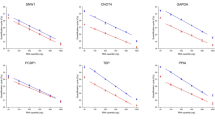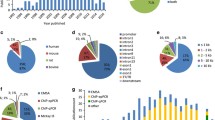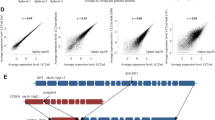Abstract
Comparing 5 publications from China that described knockdowns of the human TPD52L2 gene in human cancer cell lines identified unexpected similarities between these publications, flaws in experimental design, and mis-matches between some described experiments and the reported results. Following communications with journal editors, two of these TPD52L2 publications have been retracted. One retraction notice stated that while the authors claimed that the data were original, the experiments had been out-sourced to a biotechnology company. Using search engine queries, automatic text-analysis, different similarity measures, and further visual inspection, we identified 48 examples of highly similar papers describing single gene knockdowns in 1–2 human cancer cell lines that were all published by investigators from China. The incorrect use of a particular TPD52L2 shRNA sequence as a negative or non-targeting control was identified in 30/48 (63%) of these publications, using a combination of Google Scholar searches and visual inspection. Overall, these results suggest that some publications describing the effects of single gene knockdowns in human cancer cell lines may include the results of experiments that were not performed by the authors. This has serious implications for the validity of such results, and for their application in future research.


Similar content being viewed by others
Notes
More information of the PubMed similar function: https://www.ncbi.nlm.nih.gov/books/NBK3827/#pubmedhelp.Computation_of_Similar_Articles.
References
Altman, D. G. (2002). Poor-quality medical research: What can journals do? JAMA, 287(21), 2765–2767. doi:10.1001/jama.287.21.2765.
Amancio, D. R. (2015). Comparing the topological properties of real and artificially generated scientific manuscripts. Scientometrics, 105(4), 1763–1779. doi:10.1007/s11192-015-1637-z.
Amancio, D. R., Aluisio, S. M., Oliveira, O. N., & Costa, L. da F. (2012). Complex networks analysis of language complexity. Europhysics Letters, 100(5), 58002. doi:10.1209/0295-5075/100/58002.
Anderson, M. S., Ronning, E. A., De Vries, R., & Martinson, B. C. (2007). The perverse effects of competition on scientists’ work and relationships. Science and Engineering Ethics, 13(4), 437–461. doi:10.1007/s11948-007-9042-5.
Argamon, S., & Levitan, S. (2005). Measuring the usefulness of function words for authorship attribution. In Proceeding of the 2005 ACH/ALLC conference, June 2005, Victoria, BC, Canada.
Ausloos, M., Nedic, O., Fronczak, A., & Fronczak, P. (2016). Quantifying the quality of peer reviewers through Zipf’s law. Scientometrics, 106(1), 347–368. doi:10.1007/s11192-015-1704-5.
Bik, E. M., Casadevall, A., & Fang, F. C. (2016). The prevalence of inappropriate image duplication in biomedical research publications. mBio, 7(3), e00809–e00816. doi:10.1128/mBio.00809-16.
Bohannon, J. (2015). Hoax-detecting software spots fake papers. Science, 348(6230), 18–19. doi:10.1126/science.aab0381.
Bornmann, L. (2013). Research misconduct-definitions, manifestations and extent. Publications, 1, 87–98. doi:10.3390/publications1030087.
Bowen, A., & Casadevall, A. (2015). Increasing disparities between resource inputs and outcomes, as measured by certain health deliverables, in biomedical research. Proceedings of the National Academy of Sciences of the United States of America, 112(36), 11335–11340. doi:10.1073/pnas.1504955112.
Boyer-Guittaut, M., Poillet, L., Liang, Q., Bôle-Richard, E., Ouyang, X., Benavides, G. A., et al. (2014). The role of GABARAPL1/GEC1 in autophagic flux and mitochondrial quality control in MDA-MB-436 breast cancer cells. Autophagy, 10(6), 986–1003. doi:10.4161/auto.28390.
Butler, L. (2003). Explaining Australia’s increased share of ISI publications—The effects of a funding formula based on publication counts. Research Policy, 32(1), 143–155. doi:10.1016/S0048-7333(02)00007-0.
Byrne, J. A., Frost, S., Chen, Y., & Bright, R. K. (2014). Tumor protein D52 (TPD52) and cancer—Oncogene understudy, or understudied oncogene? Tumour Biology, 35(8), 7369–7382. doi:10.1007/s13277-014-2006-x.
Capes-Davis, A., & Neve, R. M. (2016). Authentication: A standard problem or a problem of standards? PLoS Biology, 14(6), e1002477. doi:10.1371/journal.pbio.1002477.
Carpena, P., Bernaola-Galván, P., Hackenberg, M., Coronado, A. V., & Oliver, J. L. (2009). Level statistics of words: Finding keywords in literary texts and symbolic sequences. Physical Review E: Statistical, Nonlinear, and Soft Matter Physics, 79(3 Pt 2), 035102. doi:10.1103/PhysRevE.79.035102.
Casadevall, A., Steen, R. G., & Fang, F. C. (2014). Sources of error in the retracted scientific literature. The FASEB Journal, 28(9), 3847–3855. doi:10.1096/fj.14-256735.
Citron, D. T., & Ginsparg, P. (2015). Patterns of text reuse in a scientific corpus. Proceedings of the National Academy of Sciences of the United States of America, 112(1), 25–30. doi:10.1073/pnas.1415135111.
Cover, T. M., & Hart, P. E. (1967). Nearest neighbor pattern classification. IEEE Transactions on Information Theory, IT-13, 21–27.
Delgado López-Cózar, E., Robinson-García, N., & Torres-Salinas, D. (2014). The Google scholar experiment: How to index false papers and manipulate bibliometric indicators. Journla of the Association for Information Science and Technology, 65, 446–454. doi:10.1002/asi.23056.
Djuric, D. (2015). Penetrating the omerta of predatory publishing: The Romanian connection. Science and Engineering Ethics, 21(1), 183–202. doi:10.1007/s11948-014-9521-4.
Fahrenberg, U., Biondi, F., Corre, K., Jégourel, C., Kongshøj, S., & Legay, A. (2014). Measuring global similarity between texts. In L. Besacier et al. (Eds.), Statistical language and speech processing, lecture notes in computer science (Vol. 8791, pp. 220–232). Switzerland: Springer International Publishing. doi:10.1007/978-3-319-11397-5_17.
Fanelli, D. (2009). How many scientists fabricate and falsify research? A systematic review and meta-analysis of survey data. PLoS ONE, 4(5), e5738. doi:10.1371/journal.pone.0005738.
Fang, F. C., & Casadevall, A. (2015). Competitive science: Is competition ruining science? Infection and Immunity, 83(4), 1229–1233. doi:10.1128/IAI.02939-14.
Fang, F. C., Steen, R. G., & Casadevall, A. (2012). Misconduct accounts for the majority of retracted scientific publications. Proceedings of the National Academy of Sciences of the United States of America, 109(42), 17028–17033. doi:10.1073/pnas.1212247109.
Ferguson, C., Marcus, A., & Oransky, I. (2014). The peer-review scam. Nature, 515(7528), 480–482.
Ginsparg, P. (2014). Automated screening: Arxiv screens spot fake papers. Nature, 508(7494), 44. doi:10.1038/508044a.
He, Y., Chen, F., Cai, Y., & Chen, S. (2015). Knockdown of tumor protein D52-like 2 induces cell growth inhibition and apoptosis in oral squamous cell carcinoma. Cell Biology International, 39(3), 264–271. doi:10.1002/cbin.10388.
He, Y., Chen, F., Cai, Y., & Chen, S. (2016). Retracted: Knockdown of tumor protein D52-like 2 induces cell growth inhibition and apoptosis in oral squamous cell carcinoma. Cell Biology International, 40(3), 361. doi:10.1002/cbin.10593.
Hockey, S., & Martin, J. (1988). OCP users’ manual. Oxford: Oxford University Computing Service.
Hvistendahl, M. (2013). China’s publication bazaar. Science, 342(6162), 1035–1039. doi:10.1126/science.342.6162.1035.
Konwisorz, A., Springwald, A., Haselberger, M., Goerse, R., Ortmann, O., & Treeck, O. (2010). Knockdown of ICB-1 gene enhanced estrogen responsiveness of ovarian and breast cancer cells. Endocrine-Related Cancer, 17(1), 147–157. doi:10.1677/ERC-09-0095.
Kornfeld, D. S. (2012). Perspective: Research misconduct: The search for a remedy. Academic Medicine, 87(7), 877–882. doi:10.1097/ACM.0b013e318257ee6a.
Kreutzberg, G. W. (2004). The rules of good science. EMBO Reports, 5(4), 330–332. doi:10.1038/sj.embor.7400136.
Labbé, C., & Labbé, D. (2012). Detection of hidden intertextuality in the scientific publications. In 11th International conference on textual data statistical analysis, 2012, Liège, Belgium (pp. 537–551). Liège: LASLA - SESLA.
Labbé, C., & Labbé, D. (2013). Duplicate and fake publications in the scientific literature: How many SCIgen papers in computer science? Scientometrics, 94(1), 379–396. doi:10.1007/s11192-012-0781-y.
Lesk, M. (2015). How many scientific papers are not original? Proceedings of the National Academy of Sciences of the United States of America, 112(1), 6–7. doi:10.1073/pnas.1422282112.
Lin, S. (2013). Why serious academic fraud occurs in China. Learned Publishing, 26(1), 24–27. doi:10.1087/20130105.
Mehri, A., Darooneh, A. H., & Shariati, A. (2012). The complex networks approach for authorship attribution of books. Physica A: Statistical Mechanics and its Applications, 391(7), 2429–2437. doi:10.1016/j.physa.2011.12.011.
Michels, C., & Schmoch, U. (2012). The growth of science and database coverage. Scientometrics, 93(3), 831–846. doi:10.1007/s11192-012-0732-7.
Moore, R. A., Derry, S., & McQuay, H. J. (2010). Fraud or flawed: Adverse impact of fabricated or poor quality research. Anaesthesia, 65(4), 327–330. doi:10.1111/j.1365-2044.2010.06295.x.
Nourse, C. R., Mattei, M. G., Gunning, P., & Byrne, J. A. (1998). Cloning of a third member of the D52 gene family indicates alternative coding sequence usage in D52-like transcripts. Biochimica et Biophysica Acta, 1443(1–2), 155–168.
Nuijten, M. B., Hartgerink, C. H. J., van Assen, M. A. L. M., Epskamp, S., & Wicherts, J. M. (2015). The prevalence of statistical reporting errors in psychology (1985–2013). Behavior Research Methods. doi:10.3758/s13428-015-0664-2.
Pan, Z. Y., Yang, Y., Pan, H., Zhang, J., Liu, H., Yang, Y., et al. (2015). Lentivirus-mediated TPD52L2 depletion inhibits the proliferation of liver cancer cells in vitro. International Journal of Clinical and Experimental Medicine, 8(2), 2334–2341.
Parolo, P. D. B., Pan, R. K., Ghosh, R., Huberman, B. A., Kaski, K., & Fortunato, S. (2015). Attention decay in science. Journal of Informetrics, 9(4), 734–745. doi:10.1016/j.joi.2015.07.006.
Pautasso, M. (2012). Publication growth in biological sub-fields: Patterns, predictability and sustainability. Sustainability, 4(12), 3234–3247. doi:10.3390/su4123234.
Retraction. (2016). Lentivirus-mediated TPD52L2 depletion inhibits the proliferation of liver cancer cells in vitro [Retraction]. International Journal of Clinical and Experimental Medicine, 9(6), 12416.
Roslan, N., Bièche, I., Bright, R. K., Lidereau, R., Chen, Y., & Byrne, J. A. (2014). TPD52 represents a survival factor in ERBB2-amplified breast cancer cells. Molecular Carcinogenesis, 53, 807–819. doi:10.1002/mc.22038.
Shehata, M., Bieche, I., Boutros, R., Weidenhofer, J., Fanayan, S., Spalding, L., et al. (2008). Non-redundant functions for tumor protein D52-like proteins support specific targeting of TPD52. Clinical Cancer Research, 14, 5050–5060. doi:10.1158/1078-0432.
Shvets, A. (2014). A method of automatic detection of pseudoscientific publications. In: D. Filev et al. (Eds.), Intelligent systems′2014, advances in intelligent systems and computing (Vol. 323, pp. 533–539). Switzerland: Springer International Publishing. doi:10.1007/978-3-319-11310-4_46.
Siebert, S., Machesky, L. M., & Insall, R. H. (2015). Overflow in science and its implications for trust. Elife. doi:10.7554/eLife.10825.
Smith, R. (2006). Research misconduct: The poisoning of the well. Journal of the Royal Society of Medicine, 99(5), 232–237. doi:10.1258/jrsm.99.5.232.
Stamatatos, E. (2009). A survey of modern authorship attribution methods. Journal of the American Society for Information Science and Technology, 60(3), 538–556. doi:10.1002/asi.21001.
Steen, R. G. (2011a). Retractions in the scientific literature: Do authors deliberately commit research fraud? Journal of Medical Ethics, 37(2), 113–117. doi:10.1136/jme.2010.038125.
Steen, R. G. (2011b). Misinformation in the medical literature: What role do error and fraud play? Journal of Medical Ethics, 37(8), 498–503. doi:10.1136/jme.2010.041830.
Tian, M., Su, Y., & Ru, X. (2016). Perish or publish in China: Pressures on young Chinese scholars to publish in internationally indexed journals. Publications, 4, 9. doi:10.3390/publications4020009.
Tuzzi, A. (2010). What to put in the bag? Comparing and contrasting procedures for text clustering. Statistica Applicata-Italian Journal of Applied Statistics, 22(1), 81–98.
van Dalen, H., & Henkens, K. (2012). Intended and unintended consequences of a publish-or-perish culture: A worldwide survey. JASIS&T, 63(7), 1282–1293. doi:10.1002/asi.22636.
Verma, S., Tabb, M. M., & Blumberg, B. (2009). Activation of the steroid and xenobiotic receptor, SXR, induces apoptosis in breast cancer cells. BMC Cancer, 9, 3. doi:10.1186/1471-2407-9-3.
Wang, Z., Sun, J., Zhao, Y., Guo, W., Lv, K., & Zhang, Q. (2014). Lentivirus-mediated knockdown of tumor protein D52-like 2 inhibits glioma cell proliferation. Cellular and Molecular Biology (Noisy-le-grand), 60(1), 39–44.
Wang, X., Xu, S., Peng, L., Wang, Z., Wang, C., Zhang, C., et al. (2012). Exploring scientists’ working timetable: Do scientists often work overtime? Journal of Informetrics, 6(4), 655–660. doi:10.1016/j.joi.2012.07.003.
White, C. (2005). Suspected research fraud: Difficulties of getting at the truth. BMJ, 331(7511), 281–288. doi:10.1136/bmj.331.7511.281.
Wilson, S. H., Bailey, A. M., Nourse, C. R., Mattei, M. G., & Byrne, J. A. (2001). Identification of MAL2, a novel member of the MAL proteolipid family, though interactions with TPD52-like proteins in the yeast two-hybrid system. Genomics, 76(1–3), 81–88. doi:10.1006/geno.2001.6610.
Xu, J., Wang, W., Zhu, Z., Wei, Z., Yang, D., & Cai, Q. (2015). Tumor protein D52-like 2 accelerates gastric cancer cell proliferation in vitro. Cancer Biotherapy and Radiopharmaceuticals, 30(3), 111–116. doi:10.1089/cbr.2014.1766.
Yang, M., Wang, X., Jia, J., Gao, H., Chen, P., Sha, X., et al. (2015). Tumor protein D52-like 2 contributes to proliferation of breast cancer cells. Cancer Biotherapy and Radiopharmaceuticals, 30(1), 1–7. doi:10.1089/cbr.2014.1723.
Ye, X.-F., Yu, D.-H., & He, J. (2013). The rise in meta-analyses from China. Epidemiology, 24(2), 335–336. doi:10.1097/EDE.0b013e31828264be.
Zeng, W., & Resnik, D. (2010). Research integrity in China: Problems and prospects. Developing World Bioethics, 10(3), 164–171. doi:10.1111/j.1471-8847.2009.00263.x.
Acknowledgements
We thank Ms Mara Hvistendahl for invaluable support and assistance. JAB thanks journal editors and peer reviewers for their assistance, and members of the Children’s Cancer Research Unit for discussions.
Author information
Authors and Affiliations
Corresponding authors
Rights and permissions
About this article
Cite this article
Byrne, J.A., Labbé, C. Striking similarities between publications from China describing single gene knockdown experiments in human cancer cell lines. Scientometrics 110, 1471–1493 (2017). https://doi.org/10.1007/s11192-016-2209-6
Received:
Published:
Issue Date:
DOI: https://doi.org/10.1007/s11192-016-2209-6




